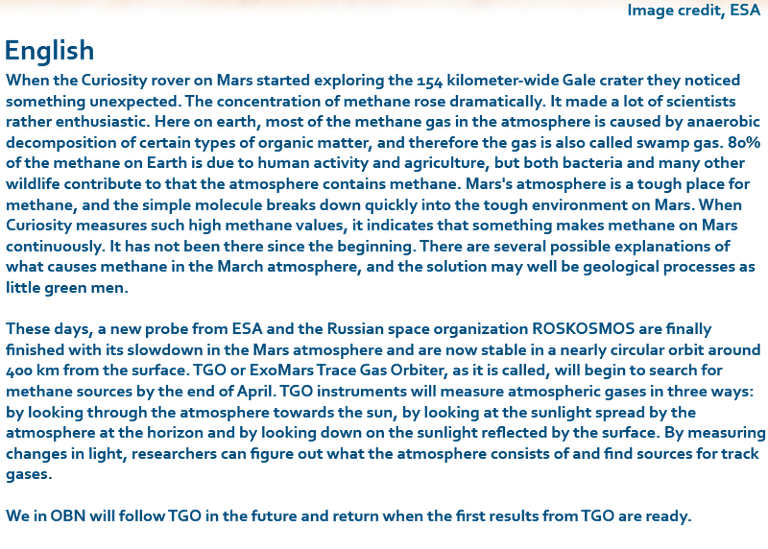One Bit News - Technology - Issue 17
7 years ago in #norway by onebitnews (64)
$15.03
- Past Payouts $15.03
- - Author $11.37
- - Curators $3.66
30 votes
- tommyhansen: $5.40
- barbro: $4.20
- babsboard: $1.87
- onebitnews: $0.97
- momar: $0.72
- valth: $0.57
- tbnfl4sun: $0.40
- norwegianviking: $0.31
- flatman: $0.25
- k3nb0b: $0.07
- driftnerd: $0.06
- alvheid: $0.04
- digitree: $0.03
- redouanemez: $0.03
- idigit: $0.03
- aminekad: $0.02
- hasmez: $0.02
- steemtux: $0.01
- marketstack: $0.00
- duekie: $0.00
- and 10 more






Gledar meg til Musk'en skal sende opp sin første settlement på Mars. Blir spennande å sjå korleis det går. Det blir nok kanskje den feitaste reality-serien hittil - å sitje å følgje med på nybyggjar livet på Mars. Vi har mykje spennande i vente på dette området.

Det kommer nok til å overgå det meste Discovery har på sendeplanen i dag ja. Mener å huske at folkene bak "big brother" sikret seg rettighetene til dette eventyret for en tid tilbake. Å stemme ut folk får en en ekstra dimmensjon i denne settingen ;)
@Onebitnews
Haha, det skulle eg vurdert å sett!
Mars has many surprises! In 2013, the American rover Curiosity had decreed that there was no methane in its atmosphere, whereas this gas had previously been measured from Earth or probes sent around the Red Planet. The hopes of those who thought they could find life were then showered. On Earth, in fact, methane is a gas that is mainly due to the activity of living beings.
Yes, and it looks like Mars is berating Methane thru the shifting seasons. Higher concentrations in the summertime then in the (colder) winter.
@Onebitnews
There are two ways for methane to be formed on Mars by active volcanoes, something that has not been detected on Mars yet, or by microbes.
Hi @Smer,
Accordingly to some geologists methane can be produced in other processes as well. But the fact that a short lived "bio-indicator" is found in the martian atmosphere is encouraging.
It is also suggested that the methane can some from meteors.
@Onebitnews
Yes this is possible that methane can be composed of meteors because of the components contained in it, that give it a special color for example, Sodium atoms give the yellow or orange color, the iron atoms give it yellow, the magnesium atoms give it the greenish blue, the calcium atoms give it the violet color, and the silicon atoms give it the red color.
Maybe its life deeper down, or maybe its just gass seeping out from life that once was. Will be interesting to follow.
More free fuel or water when we get to mars!
That,s right. Fuel!
If we bother to extract 0.8 parts pr billion that is... Have to sift thru quite few cubic kilometers of Marian atmosphere to get enough boil a cup of tea. :)
@Onebitnews
I think this is a very important topic in terms of its precedents presented in this technology issue.
as already mentioned in previous weeks, the existence of metals and the signs of the possibility of living on Mars and the need to further develop research in the exploration of space. this issue reinforces previous ideas.
Life on Mars has been talked about for a long time, and several theories and research have confirmed that, that's why I chose you this little video entitled: "Life Could Exist on March Thanks to Methane"
Nice video!
Thanks for sharing.
Sure, Methane could be both the source for metabolism or their "exhaust-gas", both scenarios is possible.
@Onebitnews
I guess with all the methane on Mars it would be not very habitable or will they be able to convert the methane into energy?
It will be very interesting to s the results from this program in the future!
Hi @Tbnfl4sun
It's not that much, it 8e-8% Methane in the Martian atmosphere. (0.8 parts per billion).
We will follow this mission closely in the time to come. :)
@Onebitnews
Wide variety of possible sources
Methane can indeed come from a wide variety of sources: transformation of a rock, olivine; ultraviolet radiation degradation of organic molecules from meteorites; production by the impact of comets; salting out from clathrates, frozen gases trapped beneath the surface, or other gases adsorbed on the regolith, dust left on the surface by the impact of meteorites; erosion of basalt containing methane inclusions; geothermal production. But none of these explanations are totally consistent with the observations.
scientific reaserch in space is very important because it gives satisfactory answers to the topics it has dealt with, but in my opinion they are much more interesting by the high technology they develop and use for theses researchs, for instance, it is largely thanks to the conquest of space that the world today is strongly interconnected.
The scientists explained that methane comes from several different sources, including the conversion of rock, the dissolution of ultraviolet rays of the organic particles that come from the meteorite from the production of the collision of the comet and the frozen gases that disappear under the surface and eat basalt stone containing methane content or microbial activities.
The discovery of traces of methane in the atmosphere of Mars in 2004 has renewed speculation about the presence of life on the red planet. Indeed, this gas should not remain long in the Martian atmosphere which implies that any source renews the content. Among the possible origins, the one that fascinates the most is obviously in the form of microorganisms that would be cousins of terrestrial methanogens. These are archaea that can thrive in extreme environments like deserts, Greenland ice and even geysers and hydrothermal vents. To develop, they need only carbon dioxide and hydrogen as a source of energy because they are not photoautotrophic organisms (performing photosynthesis), but chemotropic. Anaerobic, they are therefore able to thrive in anoxic environments, without oxygen, and devoid of organic matter. Clearly, they are indeed extremophiles and researchers have of course wondered if they would not be able to survive on Mars.

At the beginning of its history, Mars was much more welcoming, with vast expanses of liquid water and active volcanism, like the young Earth. Life could very well have appeared and take the time to adapt to conditions slowly becoming increasingly difficult. Just as terrestrial methanogens exist in the soil, and even at great depth in the rocks, some descendants of the first similar Martian microorganisms could still exist, and this may be in the vicinity of the Martian volcanoes. It would therefore be their methane generating activity that would be detected today by the Martian probes.

Hi @hope-espoir
Yes, Mars had it going for itself in the beginning, but both being too small (only 0.15 times the mass of earth) and further away from the sun advanced life didn't stand a chance.
@Onebitnews
Hi @onebitnews
Mars is the fourth planet in the solar system, between 207 and 209 million
kilometers from the sun, its equatorial radius is 3,402.45 km, about half of the Earth.
the real question is if the
life may have been possible, or may be possible in the planet Mars
scientists have recently found organic compounds in Martian rock samples.
Using SAM they have also detected sharp increases and decreases in methane levels in the atmosphere.